Ground effect
First of all, ground effect in racing, discussed in this article, should not be confused with Airplane Wing In Ground Effect (WIG). For those who want to know more about Wing In Ground Effect (WIG), pure aerodynamics, but this time about airplane wings in Ground Effect, checks this article.
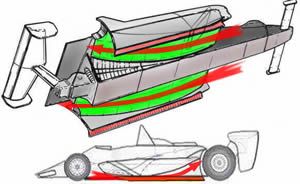 |
First real Formula 1 wing car Lotus79b |
Once the potential of using aerodynamic downforce to win races was realized, designers began experimenting with methods other than simply attaching inverted wings. Formula One technology developed at a furious pace in the 1970s and early 1980s, as F1 designers mastered the art of making airflow work to produce downforce. But the price was the death of Jochen Rindt and the end of the classic Nürburgring after Niki Lauda's horrific, flaming 1976 accident.
Ground effects was another innovation brought to F1 by Colin Chapman's Lotus team. It was borne of an idea of making the entire car function as one giant wing to increase downforce.
Up to the early 1960s, racecar engineers only focused on making car ‘streamlined’ and minimizing drag. However, as the vehicles became faster, they started to become very unstable, leading to spectacular accidents. After observations of these accidents they became aware that the streamlined cars in high speed were producing aerodynamic lift, in other words, they were trying to become airborne. This greatly reduced the grip available on the car, especially during high speed turning.
 The first attempts to resolve the problem were by trying to disturb the flow, so that it would not be that of a wing like profile. This lead to the use of "spoilers" which in many cases not only eliminated drag, but also contributed to the downforce.
The first attempts to resolve the problem were by trying to disturb the flow, so that it would not be that of a wing like profile. This lead to the use of "spoilers" which in many cases not only eliminated drag, but also contributed to the downforce.
Another idea, also using spoilers, but in the lower portion, was to try and have most of the air flow on the upper part of the car, this was done by blocking the bottom front of the car with some kind of plate (front spoiler). The Ferrari 330 P3/4 was amongst the first competition cars to use them. In the picture up the rear spoiler can be seen.
The desire to further increase the tire grip led the major revolution in racing car design, the introduction of inverted wings, which produce negative lift or downforce.
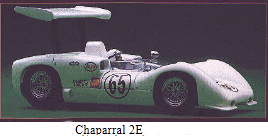 The aerodynamic downforce revolution actually started when the Chaparral 2D appeared in 1966. This car had controllable wing incidence, and won at Nurburgring. Then Chaparral 2E, which made Jim Hall be credited as the first racer to race a car with aerofoils, appeared at Bridgehampton in the same year. The controllable wing incidence was introduced to lower the drag produced by wings (by putting them in a horizontal position during long straight runs).
The aerodynamic downforce revolution actually started when the Chaparral 2D appeared in 1966. This car had controllable wing incidence, and won at Nurburgring. Then Chaparral 2E, which made Jim Hall be credited as the first racer to race a car with aerofoils, appeared at Bridgehampton in the same year. The controllable wing incidence was introduced to lower the drag produced by wings (by putting them in a horizontal position during long straight runs).
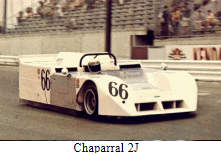 |
 |
In 1969, the Chaparral 2J presented a special downforce concept that worked well. Approach was based on controlling the low pressure under the car, independent of the vehicle's speed. This approach resulted in the so-called suction cars. |
|
Similar approach, by fitting the car with an "engine-cooling fan" to create low pressure below the car, enabled Brabham Formula 1 BT45 fan car to win one race in 1978 before it was prohibited.
Because movable aerodynamic devices were not allowed in Formula 1 at that time, engineers tended to cleverly shape the car’s underside.
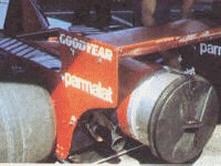 |
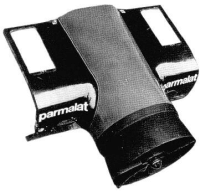 |
Rear of Brabham Formula 1 BT45 fan car, and the way they sealed engine bay |
|
Ground effects turned the entire car into a large, inverted wing, using side skirts and underbody design to literally glue the car to the circuit. The Lotus 78 was the first competitive ‘ground effect’ Formula 1 design. The underbody of it was shaped in such a way that creates a Venturi effect with the ground. Mario Andretti scored the first victory for the Lotus 78 in US GP West held in Long Beach in 1978.
Mario Andretti, who took the Lotus to the championship in 1978, explained that ground effects made the race car "...feel like it's painted to the road...".
Colin Chapman's careful development of the ground-effect car principle had rendered conventional GP machines virtually uncompetitive in a little over 12 months, as Lotus won nine of the 15 races in the '78 season. (Andretti's own championship winning race was blackned by the death of team mate Ronnie Peterson at the start of the Italian Grand Prix at Monza, an accident for which then second-year driver Ricardo Patrese was sanctioned but eventually absolved.).
Yet the other teams would catch up shortly, and 1978 would be the last time a Lotus driver would win the World Championship before Colin Chapman's death, with the Lotus team slowly declining into mediocrity and dissolution — except for brief success with the young Ayrton Senna in the mid-1980s.
It was discovered that large amounts of downforce could be generated from the airflow between the underbody of the car and the ground plane. In particular, low pressure could be created underneath the car by using the ground plane almost like the floor of a venturi duct. The ceiling of these venturi ducts took the form of inverted wing profiles mounted in sidepods between the wheels of the car. The decreasing cross-sectional area in the throat of these ducts, and the inverted wing profile accelerated the airflow and created low pressure in accordance with the Bernoulli principle. The gap between the bottom of the sidepods and the ground was sealed by so-called 'skirts'. When the rules permitted it, the skirts were suspended from the sidepods with a vertical degree of freedom to maintain a constant seal with the ground under changes in the attitude and ride height of the car. Putting it simply as possible, Ground Effect is the art of creating a low pressure area underneath the car so that the atmospheric pressure pushes the car to the ground, which is the reverse of what happens with an aircraft wing. Way this is achieved is by utilizing the Bernoulli Effect - if a moving fluid or gas is accelerated, its pressure will falls. Because lover side is longer then upper side, air has to accelerate.
Whilst the inverted wing profiles in the sidepods of ground effect cars were often dubbed 'sidewings', and the bottom of the car was often dubbed the 'underwing', these names are potentially misleading because the downforce generated is largely dependent upon the presence of the ground plane, and would not be generated in free flow. Note also that the tunnels created under the car are not strictly venturi ducts either. In a venturi duct, the sides of the duct do not move with respect to each other. In contrast, underneath such a car the ground plane and the airflow are both moving with respect to the walls and ceiling of the ducts.
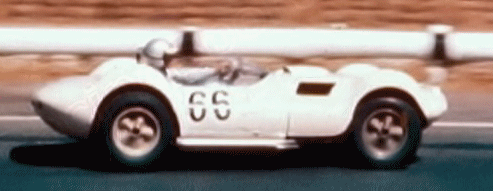 Chaparral 1 - Chevrolet V8 5450 cc
Chaparral 1 - Chevrolet V8 5450 cc
The origins of Ground Effect in racing go back to 1961, when Jim Hall was experimenting with a front-engined Chapparal-Chevrolet V8 sportscar. Jim Hall, in conjunction with the aerodynamicists of Chevrolet, built a car whose entire body shape was that of an inverted aerofoil, with both the nose and the tail upswept to form half-venturi tunnels at either end of the car, something like the modern-day diffusers seen on F1 cars. The idea was to speed up the airflow beneath the car. The problem was that the front venturi caused the car to lift, the weight of the engine being the only thing stopping the car from flipping. A massive air-dam was then fitted to counteract this, but it generated so much downforce that the wheels started to grind their way through the top of the bodywork. The concept was not fully understood, and the idea was left to languish.
The concept bubbled under the surface for a number of years, Robin Herd designing wings into the side-pods of the March 701, and Gordon Murray playing with airdams and splitters with the Brabham BT44. The concept finally saw its re-emergence with Peter Wright's brilliant Lotus 78 and Lotus 79.
The evolution of Ground Effect on the Lotus 78 came about by accident. Peter Wright was at Imperial College, London, testing out the idea of putting water radiators in the leading edge of the side-pods. In a bid to try and improve on the unsuccessful Lotus 77, Wright was using a wind tunnel with a rolling road, a novelty at the time. However, the instrumentation began to show some unrepeatable results. Closer examination showed that the side-pods on the model were sagging, and as they got closer to the floor of the wind tunnel, the downforce increased.That indicated two things: (1) that the side pods had started to generate downforce, and (2) that it had something to do with the gap between their edges and the ground.
Wright then proceeded to cut up bits of cardboard, extending the side-pods right down to the ground - the downforce level doubled. This accidental discovery showed the importance of maintaining an air-tight seal along the bottom of a car with profiled side-pods, and resulted in the successful Lotus 78 of 1977. The prototype, known as JPS/15 or 78/1, was first driven by Eddie Dennis, the shop foreman, at Hethel, but subsequent development work was done by Gunnar Nilsson. This car was later sold to Hector Rebaque, while Team Lotus raced JPS/16 and JPS/17 (78/2 and 78/3). Andretti, in 78/3 (down, in the car's debut race in Argentina), won four races for Lotus, but had many reliability problems through the year. As the advantage of the car wasn't clear cut, most of the other teams hadn't understand technical advantage. Colin Chapman himself publicly attributed his team's success to the special differential and its preferential tank-draining system - anything in fact but Ground Effect, in order to hide the discovery.
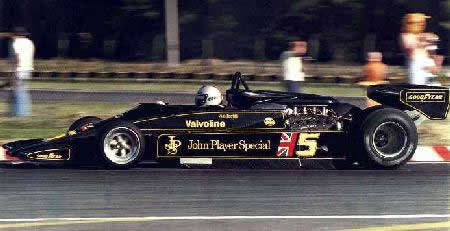
Mario Andretti in his Lotus 78
The "problem" with the Lotus 78 was that the centre of pressure was too far forward in the car, which resulted in the drivers having to run with lots of rear wing in order to prevent too much oversteer, with a corresponding lack in straight-line speed. This was rectified in the Lotus 79.
Apart from construction differences (sheet aluminium being used rather than aluminium honeycomb, as Ralph Bellamy, the main advocate of the material, had left for Copersucar), the major difference was in the treatment of the rear suspension, everything being moved in order to reduce the amount of drag in the air exiting the side-pod. This resulted in the aerodynamic load being generated over the whole car length, rather than mostly at the front, and gained the Lotus 79 25% more downforce than the Lotus 78. The prototype, JPS/19 (or 79/1), was rolled out at Paul Ricard in December 1977.
The effect of the huge increase in downforce had not been anticipated, and the car fatigued extremely quickly. A second version, much strengthened (JPS/20, or 79/2), was entered in the BRDC International Trophy at Silverstone on 19 March, the first three Grand Prix having been entered with Lotus 78s. The race was flooded out, but Andretti soon took his car into the lead before aquaplaning off at Abbey, damaging the car extensively. It may have been an inauspicious start, but the concept had been proved, and once the Getrag gearbox was swapped for a Hewland, there was no stopping it. Once Peterson had set stunning times practising at Anderstorp, the car was taken to Zolder for the Belgian GP, its first World Championship race. It (JPS/20) was originally meant to be Andretti's spare car, but the team engineer Nigel Bennett reckoned it could be made into a race car. Andretti talked to Chapman, and both put $500 into a kitty to be split between the mechanics if the 79 survived the race distance without a failure. Andretti qualified on pole by over a second, and led from start to finish... At the next Grand Prix in Jarama, Andretti and Peterson qualified 1st and 2nd, and finished 1st and 2nd, taking fastest lap along the way. The rest of the field was left standing. However, Brabham designer Gordon Murray had an idea.
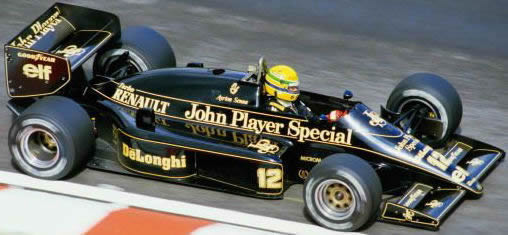 Airton Sena in Lotus JPS 1986
Airton Sena in Lotus JPS 1986
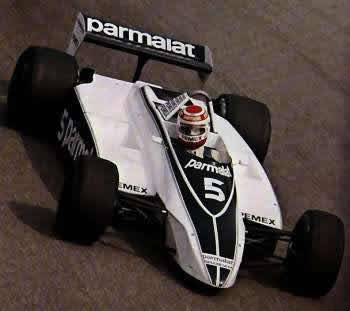
Brabham BT49-02
Murray's take on the ground effect design of Colin Chapman's, and his BT49 was the most successful of all Brabhams, winning the driver's championship with Nelson Piquet aboard in 1981. After driving the BT49 for the first time in 1982, Piquet's new teammate, Riccardo Patrese, remarked that "anyone could win races in that car!"
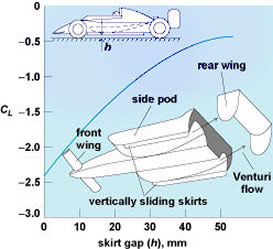 |
Creation of downforce with side skirts. Graph shows effect of side-skirt-to-ground gap h on a vehicle's total downforce coefficient, −CL. The gap h is defined in the upper inset diagram, and the underbody of the race car is diagrammed in the lower inset. 1 mm = 0.04 in. |
Piquet responded with, "Yes, and it took us two years to make it that good…"
Despite their advances, ground effects had a problem, namely that slight miscalculations in set-up would render the ground-effect F1 car undriveable and wickedly unstable. The need to keep ground clearances extremely low led to rigidly sprung, rock-hard cars with virtually no ride height tolerance and little if any ability to handle bumps and curbs. Something really terrible, unnatural and unpredictable would happen if the airflow beneath the car was disrupted for one reason or another.
While the "more is better" ground effect theory seemed good on paper - and indeed in the windtunnel - in reality these cars proved highly unpredictable, never able to guarantee a constant level of downforce. The low pressure area in particular proved hard to control, often moving around, leading to an alarming new phenomenon known as "porpoising" where the car would dip and heave, or in some cases disappearing altogether when a skirt became dislodged or broken.
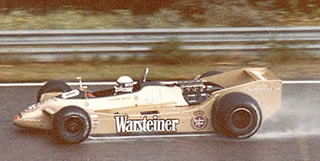 |
| Arrows A2, 1979 Dutch GP, Jochen Mass |
The flow volume between the vehicle and the ground is strongly dependent on the car's attitude relative to the ground. Very small ground clearance results in positive lift, since there is almost no airflow between the underbody and the ground. With increasing ground clearance the airflow produces low pressures causing overall lift to be lowered to negative values and then to rise again as ground clearance
continues to increase. This is due to the fact that the flow velocity under the car decreases as ground clearance increases. in this case, more downforce can be generated using a diffuser between the rear wheels. The air enters the diffuser in a low-pressure, high-velocity state after accelerating under the car. By gradually increasing the cross-sectional area of the diffuser, the air gradually slows down and returns to its original free-stream speed and pressure. The diffuser's aim is to decelerate the air without it separating from the tunnel walls, which would cause a stall, reducing the downforce and inducing a large drag force. By installing an inverted wing close to the diffuser exit it is possible to create a low pressure area, which essentially sucks the air from the diffuser and helping him do the job. The diffuser and wing combination permits a higher air mass flow rate through the diffuser, thus resulting in higher downforce.
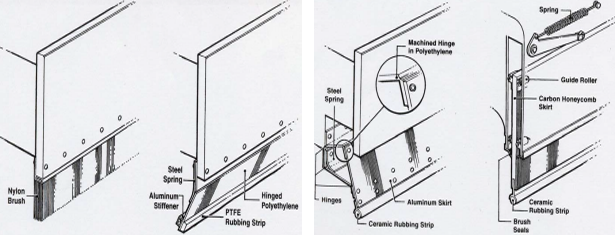 |
|||
Lotus T78 brush skirt |
Lotus T78 "suck-up"skirt |
Lotus T78 "suck-down"skirt with ceramic rubbing strip |
Lotus T79 "board in the box"skirt |
Year 1982 was last year of side skirts and real hard core ground effect. Chapman made another attempt with Lotus 91 and 91B, but without real success. On picture below you can see model 91 during French GP 1982 with Ellio de Angelis behind the wheel and model 91B from private collection. On the first picture you can clearly see side skirts touching the ground, and car without front wings.
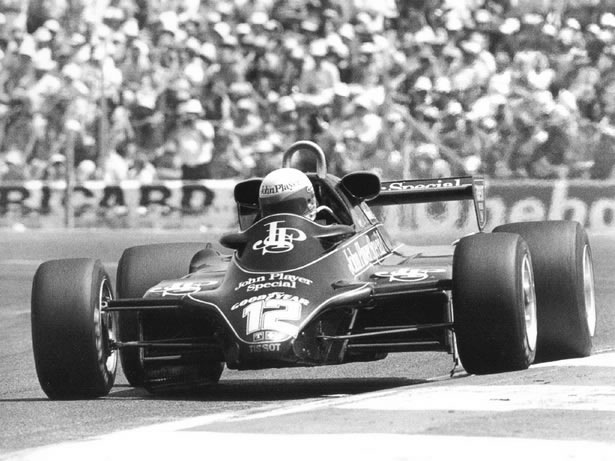
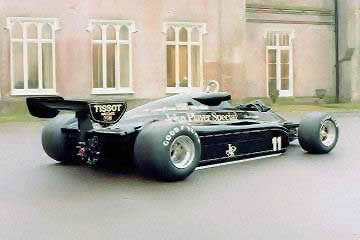
Today, F1 regulations heavily limit the effect of ground effect aerodynamics, which are a highly efficient means of creating downforce with a very small drag penalty.
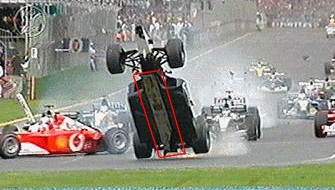
Ralf Schumacher showing his 10mm thick wooden plank ( 2006)
By FIA rules, underside of the vehicle, the undertray, must be flat between the axles. A 10mm thick wooden plank or skid block runs down the middle of the car to prevent the cars from running low enough to contact the track surface; this skid block is measured before and after a race. Should the plank be less than 9mm thick at any place after the race, the car is disqualified.
A substantial amount of downforce is provided by using a rear diffuser which rises from the undertray at the rear axle to the actual rear of the bodywork.
The limitations on ground effects, limited size of the wings (requiring use at high angles of attack to create sufficient downforce), and vortices created by open wheels lead to a high aerodynamic drag coefficient. However, this drag is more than compensated for by the ability to corner at extremely high speed.
Though Bernoulli's principle is a major source of lift or downforce in an aircraft or racing car wing, Coanda effect plays an even larger role in producing lift. To know more about interaction of Bernoulli principle and Coanda effect check my article here.
New aero rules for 2022 allow work and promote the ground effect again to allow close racing and to create downforce. A main feature of these new regulations is a switch to ground-effect aerodynamics, which have not been seen in Formula 1 since the early 1980s, meaning many engineers at Formula 1 are unfamiliar with the concept.
2022 car will feature fully shaped underfloor tunnels, rather than the stepped floor used untill 2021, which will allow teams to generate large amounts of efficient downforce through ground effect (the current floors also exploit ground effect, but not to the same extent).
The reason for the change is the benign quality of downforce generated in ground effect. Current cars' barge boards and other bits of aerodynamic furniture are designed to send vortices under the floor to increase downforce. But when those vortices stop working – due, for example, to the influence of closely following another car – the performance drop-off is huge. With the 2022 car, however, the underfloor downforce is better preserved within the tunnels, without the reliance on arrays of wake-sensitive, vortex-generating geometries – ergo better following, ergo closer racing!






